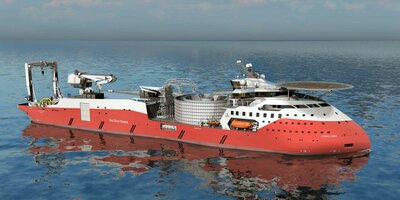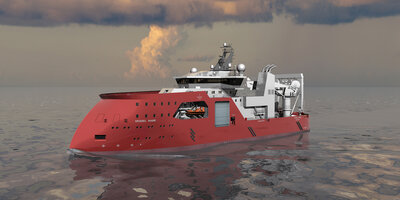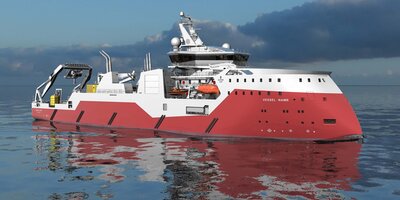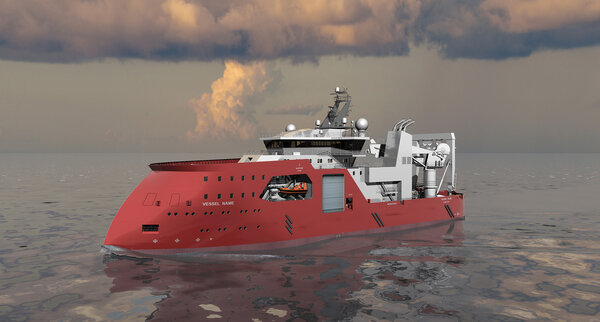
Cable Laying Vessels
Committed to delivering thoughtful vessel designs, we prioritize safety, crew comfort, and operational efficiency at a cost-effective rate. Experience the next level of industry advancement with our dependable cable-laying portfolio, where we offer continuous support throughout your vessel's lifecycle.
What is a cable-laying vessel?
A cable-laying vessel is designed to lay underwater cables on the seabed, facilitating communication and networking between offshore structures or connecting different areas and continents. These cables can be for telecommunication or electric power transmission, each with unique usability, size, and characteristics, suited for various sea depths and ground conditions. Cables can be laid directly on the seabed, buried by plough or trencher, or covered by rocks. Therefore, understanding the specific operation and operational area of the ship to be designed is crucial.
When developing a design for a cable layer, key criteria include capacity, functionality, and efficiency. Efficient cable laying, without compromising the gentle handling of different cable types, is essential for creating an excellent cable-laying vessel.
Each project's specific requirements will dictate the setup of cable equipment, around which the vessel layout is designed. To design a competitive and highly efficient cable layer, close cooperation between the design team, the owner, the cable lay equipment vendor, and other equipment suppliers is crucial. This collaboration ensures a balanced approach that considers technical, operational, and financial aspects.
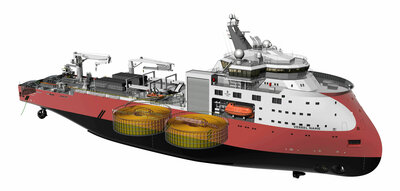
Our cable-laying vessel designs
Our fuel-efficient cable lay designs cover all cable installation projects, including power and fibre optic telecom cable, inter-array, export and interconnector cable laying. The fully integrated cable lay configuration is tailored to the owner’s requirements.
With an ULSTEIN X-BOW® Cable Laying Vessel, the vessel motions will be reduced and, consequently, also the strain on the cable. This might allow operations in worse weather conditions than a vessel with a conventional bow. Due to the absence of whipping movements in the ship, there will be less wear and tear of the cable. The X-BOW maintains its efficiency over a wide draught range from lightship to fully loaded, which is of high importance for a cable laying vessel. The X-BOW also minimises the accelerations, leading to smoother motions and a reduction in fuel consumption in waves.
Due to the precision requirements of the cable route, modern cable laying vessels need a dynamic position system. A smart and efficient system set-up is key to ensuring low fuel consumption and reduced cost and environmental footprint.
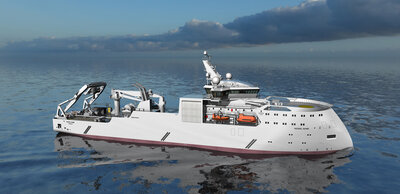
How do we contribute to the development of a cable-laying vessel?
Ulstein provides services and support in various steps and extent throughout the lifecycle of a cable lay vessel. From support in the development of the business case throughout ship design, engineering, integration and construction, power and main equipment integration, electrical services, site follow-up and turnkey shipbuilding deliveries. For sailing vessels, we offer life cycle services of different types and extent, from analysis and feasibility studies to retrofit and conversions.

Shipyard for newbuilds and conversions
Our shipyard, Ulstein Verft, is renowned for high-quality and on-time deliveries and has a proven track record in constructing Cable Laying Vessels.

The future cable laying industry
The offshore wind industry is growing rapidly, and more cable-laying vessels will be needed. Different operations will require various ship capacities, different equipment, layout and logistics.
Subsea cables are being laid at greater depths and are becoming longer, larger and heavier. There is also a need to replace damaged or obsolete cables due to maintenance costs. An essential design element is to protect the cables during and after the operation's completion. The safe burial of the cables can secure the long-term reliability of the cables, deep enough to avoid any damage caused by anchors, trawling or other subsea activity. In addition to our series of cable-laying vessels, Ulstein also has a proven track record of rock installation vessels for cable protection.
Our cable laying designs range from large, shallow-water, high cable-capacity workhorses to nimble and time-efficient cable repair vessels. These include designs for all cable installation projects, including power and telecom fibre optic vessels, inter-array, export and interconnector cable laying.
Overview of CLV types:

Export cable laying vessels
Export cable laying vessels are used in offshore wind fields to connect the offshore grid to the shore network. The offshore wind farms are established further offshore, and the wind turbines and offshore wind farms are increasing in size. This means, that the export cables are also increasing in size and in length.

Inter-array cable laying vessels
The inter-turbine (array) cable laying vessels are operating in-field at the offshore wind farms, laying power cable between the wind turbines. The cables are typically installed in single lengths from one turbine to the next. In general, wind turbines are increasing, which means that the cable size is also increasing.

Fibre-optic cable-laying vessels
Fibre-optic cable-laying vessels typically work between continents, connecting the grids and laying long stretches of subsea cables. They are powerful and have high capacity, and particular care is taken in the design process to maintain low fuel consumption even in the most power-demanding situations.
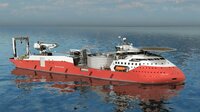
Explore our Cable Lay portfolio
Ulstein offers a range of cable-laying designs, from large shallow-water vessels to efficient repair ships, with a focus on cost-effective operations, minimising the environmental footprint and crew safety. In addition to Ulstein's yard in Norway, we work with partner yards worldwide. Contact us if you have a specific yard in mind for your next project and would like us to assist.
